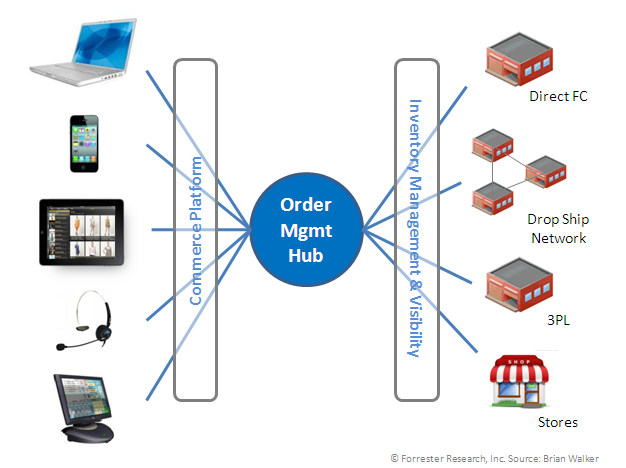Order Management Has Become A Strategic Commerce Capability
Over the last few years we have seen a shift in client requirements. Commerce solution programs and eCommerce platform projects have begun to reflect a change in how companies are beginning to do business, and in next generation capability needs they have that encompass:
- Managing orders across a diverse set of customer touchpoints. It is no longer just about the web. Today’s eBusiness is taking orders through the web, through the mobile web, through mobile apps, through marketplaces, through the contact center, and increasingly through mobile POS, sales force enablement tools, and self-service kiosks. A single order pipeline, enabled through APIs and integration tools will enable consistent order processing with security and control.

- Enabling complex fulfillment and supply chain scenarios. No longer are orders going to be fulfilled from a single fulfillment center (FC). Tomorrow's orders will be sourced from a wide variety of locations that include that FC, but also include vendor drop-shippers, distributors, stores, and third-party logistics providers who may either regionally stage high-demand products or support seasonal inventory volumes, or both. Business logic and real-time decisioning is critical to driving a high quality consumer experience and a profitable order. The benefits here are multiple, including lower transportation costs and faster time to delivery.
- Enabling inventory visibility. Today’s customer is using mobile and the web to find and locate products in stores. In stores, sales associates working with customers can drive a good experience from an out-of-stock while saving a sale and fulfilling that order from another store or from the DC to meet demand more profitably by driving inventory turns and reducing markdowns. Having inventory visibility across all locations is critical, and while still hard in many cases, the costs of this have dropped significantly.
- Supporting a growing variety of payment types and supporting tiered fraud screening. Order management tools are critical to supporting a growing set of payment types, amplified by the globalization of businesses today. And as the dollars spent on fraud screening and card reauthorizations grows in a significant number, businesses need tiered fraud screening tools that they can manage and then integrate with third-party fraud tools more selectively.
- Supporting customer service scenarios more effectively. Improving customer self service and driving efficient contact center interactions around the most common customer contact requires effective order management tools. “Where is my order,” “editing my order,” “canceling my order,” and managing order exceptions in the contact center are key to delivering high-quality customer experiences across touchpoints, while keeping service efficient in service time and money.
In the era of agile commerce, order management tools are becoming strategic. Dealing with a diverse set of customer touchpoints and fulfillment nodes is no longer a high-class problem reserved for the top-tier retailers and businesses. This is now an issue for businesses large and small. While in the past order management may have been an afterthought to the eCommerce platform, many clients today may be best served to first implement next-gen OMS capability before their next-gen commerce platform, simplifying the migration to and integration of that new platform while enabling more complex order fulfillment and inventory optimization.
The good news is that the solutions market is responding, and we are looking at this closely. We are incorporating OMS capability even further in our upcoming wave report on commerce platform suites — which is already underway — and have other research planned to support your need to find the right solutions for your business. I would love to know if you have specific OMS-related research you would like to see from us; please comment below if you have suggestions.